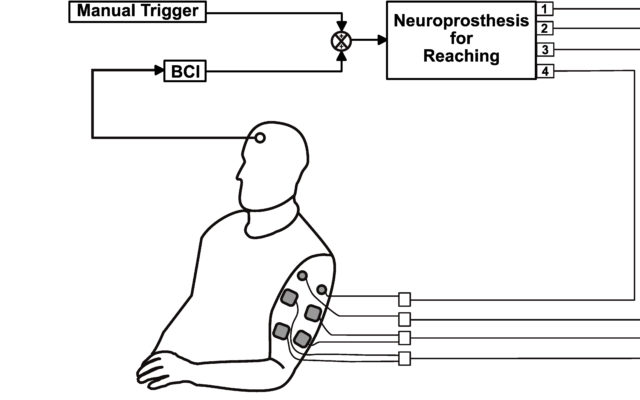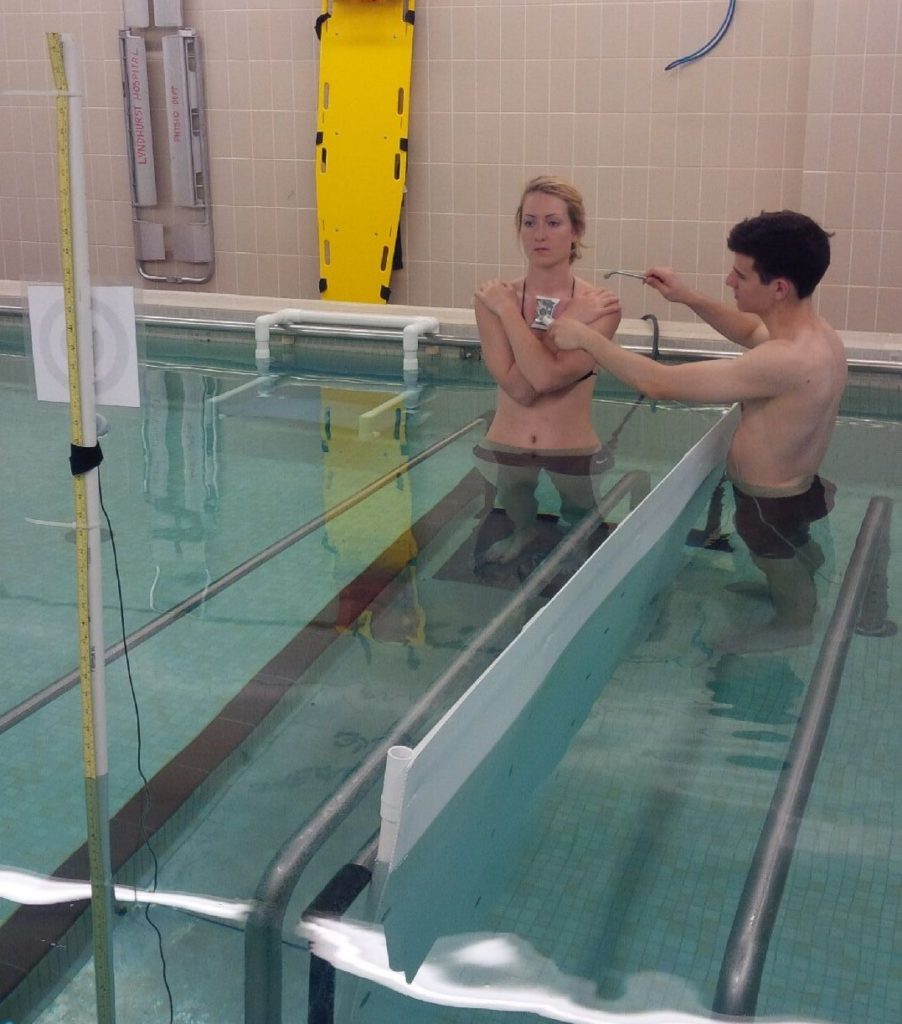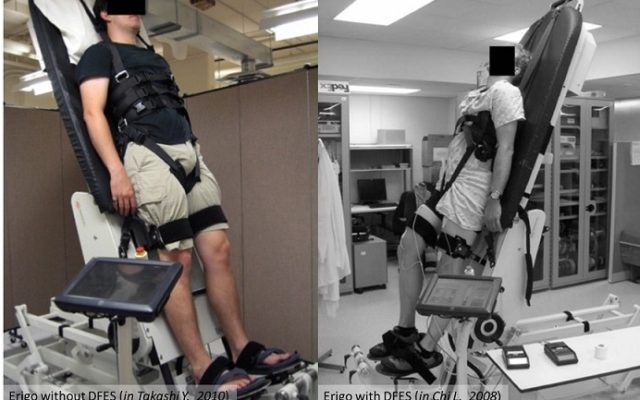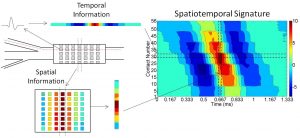BCI-controlled FES therapy for restoration of upper limb function
Cesar Marquez-Chin, Milos R Popovic
Recent evidence suggest that the integration of brain-computer interacting technologies into the motor rehabilitation after paralysis can result in greater and/or faster outcomes.
We are currently developing and testing the efficacy of functional electrical stimulation therapy (FEST), triggered by the activity of the brain, to restore voluntary movement of the arm and hand after spinal cord injury and stroke. Using brain-computer interfacing technology we identify a person’s intention to move the arm and/or hand by analyzing the electroencephalographic (EEG) activity. Immediately after this, we trigger a complex sequence of electrical pulses applied to different muscles to produce the intended action. The use of electrical stimulation is reduced gradually as the ability to move is restored and it is discontinued completely at the end of this short-term therapeutic intervention.
Our first results have allowed us to see significant improvements in even cases that typically are unable to participate in other forms of therapy.
Project Publications
- Jovanovic LI, Popovic MR, Marquez-Chin C. Characterizing the stimulation interference in electroencephalographic signals during brain-computer interface-controlled functional electrical stimulation therapy. Artif Organs. 2022;46(3):398-411. doi:10.1111/aor.14059
- Jovanovic LI, Rademeyer HJ, Pakosh M, Musselman KE, Popovic MR, Marquez-Chin C. Scoping Review on Brain-Computer Interface-Controlled Electrical Stimulation Interventions for Upper Limb Rehabilitation in Adults: A Look at Participants, Interventions, and Technology. Physiotherapy Canada. Published online April 30, 2022:e20210074. doi:10.3138/ptc-2021-0074
- Suzuki Y, Jovanovic LI, Fadli RA, et al. Evidence That Brain-Controlled Functional Electrical Stimulation Could Elicit Targeted Corticospinal Facilitation of Hand Muscles in Healthy Young Adults. Neuromodulation: Technology at the Neural Interface. Published online January 14, 2022. doi:10.1016/j.neurom.2021.12.007
- Jovanovic LI, Kapadia N, Zivanovic V, et al. Brain-computer interface-triggered functional electrical stimulation therapy for rehabilitation of reaching and grasping after spinal cord injury: a feasibility study. Spinal Cord Ser Cases. 2021;7(1):24. doi:10.1038/s41394-020-00380-4
- Jovanovic LI, Popovic MR, Marquez-Chin C. KITE-BCI: A brain-computer interface system for functional electrical stimulation therapy. The Journal of Spinal Cord Medicine. 2021;44(sup1):S203-S214. doi:10.1080/10790268.2021.1970895
- Milosevic M, Marquez-Chin C, Masani K, et al. Why brain-controlled neuroprosthetics matter: mechanisms underlying electrical stimulation of muscles and nerves in rehabilitation. Biomed Eng Online. 2020;19(1):81. doi:10.1186/s12938-020-00824-w
- Marquez-Chin C, Popovic MR. Functional electrical stimulation therapy for restoration of motor function after spinal cord injury and stroke: a review. BioMedical Engineering OnLine. 2020;19(1):34. doi:10.1186/s12938-020-00773-4
- Jovanovic LI, Kapadia N, Lo L, Zivanovic V, Popovic MR, Marquez-Chin C. Restoration of upper-limb function after chronic severe hemiplegia: A case report on the feasibility of a brain-computer interface controlled functional electrical stimulation therapy. American journal of physical medicine & rehabilitation / Association of Academic Physiatrists. Published online February 2019:1.
- Likitlersuang J, Koh R, Gong X, et al. EEG-Controlled functional electrical stimulation therapy with automated grasp selection: A proof-of-concept study. Topics in Spinal Cord Injury Rehabilitation. 2018;24(3):265-274
- C. Marquez-Chin, A. Marquis, and M. R. Popovic, “EEG-Triggered Functional Electrical Stimulation Therapy for Restoring Upper Limb Function in Chronic Stroke with Severe Hemiplegia,” Case Reports in Neurological Medicine, vol. 2016, pp. 1–11, 2016.


Influence of an aquatic environment on postural control: Implications for SCI Rehabilitation
Kei Masani, Milos R Popovic
In this project we assessed the effects of the aquatic environment on postural sway and gait initiation. Parameters of the center of pressure (COP) and trunk acceleration (upper and lower trunk) were investigated in able-bodied subjects and in individuals with incomplete spinal cord injury.Our preliminary results suggest that the aquatic medium increases postural instability and changes postural control strategies in the upper trunk in water compared to land during standing. In gait initiation, the aquatic environment seems to slow down the execution phase while increasing the COP trajectory both in anticipatory and execution phases. A new trunk strategy is evoked while initiating gait in water when compared to dry land. The parameters of participants with SCI were similar to the able-bodied subjects. Individuals with SCI reported to feel more secure in water than on land.

Dynamic FES training of sympathetic function after SCI
Milos R Popovic
Many SCI individuals suffer from orthostatic hypotension (OH), a rapid decrease in blood pressure upon changing from supine to upright position, experienced, as incapacitating dizziness (among others). Dynamic Functional Electrical Stimulation (DFES), and passive robotic leg motion synchronized with electrical stimulation of the leg muscles, during upright stance has proven to prevent immediate OH from occurring in individuals with long lasting SCI.
This study examines how DFES can be used in early rehabilitation to prevent OH from occurring and, by doing so, enable SCI individuals to participate in an intensive rehabilitation program immediately following injury.

Peripheral Nerve Interfaces
Jose Zariffa
An implanted neuroprosthesis is a device that communicates directly with the nervous system by means of electrical stimulation and/or recording. Functional electrical stimulation (FES) of motor neural pathways can be used to restore movement, but establishing a channel of communication between the artificial device and the user’s nervous system is a major challenge. In order to address this problem, we are developing techniques to extract information (sensory or motor signals) from the electrical activity of peripheral nerves. The objective of this line of research is to eventually create neuroprosthetic systems that can reproduce natural movement. Publications:- Sammut, R.G.L. Koh, J. Zariffa. “Compensation Strategies for Bioelectric Signal Changes in Chronic Selective Nerve Cuff Recordings: A Simulation Study.” Sensors, 21(2):506, 2021.
- Tovbis, A. Agur, J.P.M. Mogk, J. Zariffa, “Automatic Three-Dimensional Reconstruction of Fascicles in Peripheral Nerves from Histological Images”, PLOS One, 15(5):e0233028, 2020.
- G.L. Koh, M. Balas, A.I. Nachman, J. Zariffa, “Selective peripheral nerve recordings from nerve cuff electrodes using convolutional neural networks”, Journal of Neural Engineering, 17(1):016042, 2020.
- G.L. Koh, A.I. Nachman, J. Zariffa, “Classification of naturally evoked compound action potentials in peripheral nerve spatiotemporal recordings”, Scientific Reports, 9:11145, 2019.
- G.L. Koh, A. Nachman, J. Zariffa, “Use of spatiotemporal templates for pathway discrimination in peripheral nerve recordings: A simulation study”, Journal of Neural Engineering, 14(1):016013, 2017.
- Garai, R.G.L. Koh, M. Schuettler, T. Stieglitz, J. Zariffa, “Influence of anatomical detail and tissue conductivity variations in simulations of multi-contact nerve cuff recordings”, IEEE Transactions on Neural Systems and Rehabilitation Engineering, 25(9):1653-1662, 2017.
